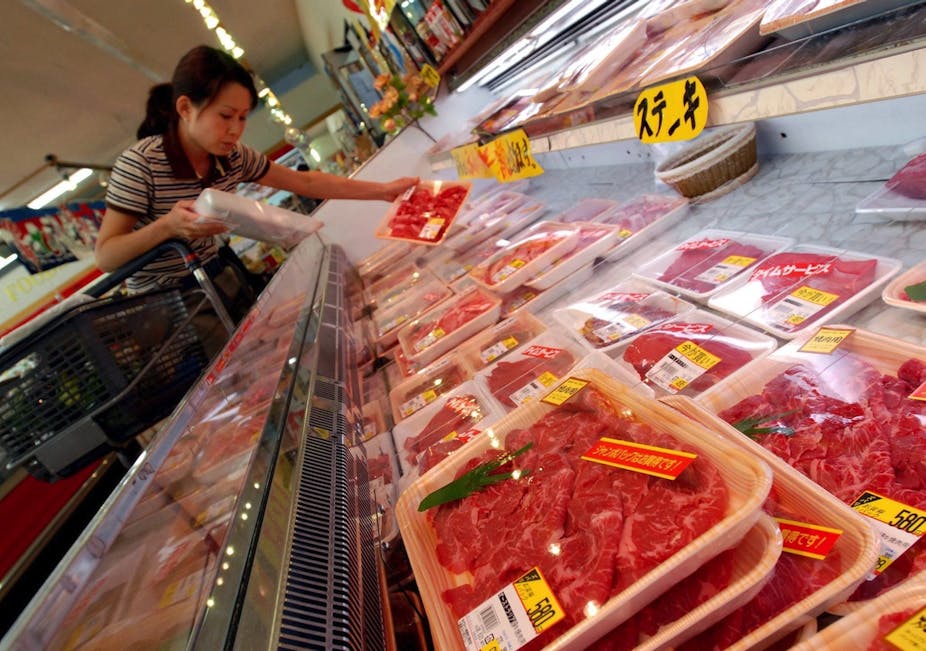The Japan-Australia Economic Partnership Agreement (JAEPA) signed last week is a bilateral trade deal in the old-fashioned mould. In the twenty-first century, global economic negotiations tend to be preoccupied with rules about investment and intellectual property, rather than trade. It is not coincidental that a member of the Liberal Party (Andrew Robb) rather than a National, has charge of this portfolio in the Abbott Government.
But the JAEPA is a twenty-first century rerun of the narrative that dominated Australian trade policy during the latter twentieth century. The Japanese wanted better opportunities to sell cars to Australians. The Abbott government’s decision to discontinue industry support for automobile makers in Australia paved this pathway. The Australian negotiators wanted better access for farm exports. The Japanese agreed to a raft of tariff reductions. Andrew Robb heralded the agreement as “historic”, and even his Labor Party predecessor chimed in, with Craig Emerson tweeting “Well done A Robb and PM”.
The EPA certainly makes a dent in the barriers facing Australian agricultural food exports to Japan, although gains are uneven. For exporters of dairy, sugar, grains, rice and pork, it provided marginal improvements at best. For beef exporters, progress was more significant.
In three years, Japan’s current 38.5% tariff on beef from Australia will be phased down to 19.5% for frozen product, and 30.5% for fresh. For a country that has a reputation for fighting inch-by-inch to protect its farmers, this is a significant change to the market access of Australian beef into Japan.
Who really wins?
However, when assessing economic agreements, one of the tricks of the trade is to remember that countries don’t export. Companies do. And as David Ricardo reminds us, freer trade tends to generate net economic gains at a national scale, but benefits and costs may be distributed unequally between geographical regions, industries, capital and labour. So before accepting the celebratory narratives of Minister Robb and Minister Emerson, we should ask who might benefit, and how.
In this regard, we’ve been in this territory before. Back in the late 1980s, countries of the world embarked on the Uruguay Round of trade negotiations. A chief goal of those talks was to dramatically free agricultural trade. The story of what happened in those years has direct relevance to today. Before 1987 there were only two Japanese companies with investments in Australian beef processing and trade. In the following few years there was a veritable stampede of Japanese integrated meat processing firms and general trading companies into the industry. They weren’t buying the farm, but they were controlling the critical market links that connected Australian beef farmers with Japanese consumers.
These companies were exploiting commercial advantages from “full-set” beef exporting. Beef demand in Japan surged in the decade from the late 1980s, largely on the back of yakiniku (beef barbecue) restaurants and an overall trend towards dietary Westernisation. These trends were reinforced when the government of Japan finally acceded to Uruguay Round agreements in 1995, and dropped beef tariffs from 50% to 38.5% within four years. For the first time, cheaper and lower quality beef became a viable export from Australia to Japan.
Because of their preemptive investments in the late 1980s, Japanese firms controlled the lion’s share of this trade. Australian beef farmers had become positioned as suppliers to a highly concentrated processing sector (half-a-dozen firms owned over half of capacity) which on-sold product to an even more highly concentrated set of trading channels operated by Japanese firms. Although the Australian economy did receive net gains from being able to export more beef to Japan, the magnitude of those benefits was truncated by the structuring of value chains in accordance with buyer, not supplier, interests.
The story of the Australia-Japan beef trade in the 1980s and 1990s tells a wider parable about international economic agreements and agriculture. Global food trade is today increasingly orchestrated around tightly controlled captive value chains. A key attribute of corporate strategy by global supermarket chains, trading companies and multinational food processing firms is to coordinate their international activities through intra-firm trade. By replacing open market purchases with captive, non-arms length transactions, these firms better control the prices and terms in which international commerce takes place. This is certainly the way the Australia-Japan beef trade has evolved.
It is well and good that the JAEPA will allow increased market access for Australian beef into Japan. Industry associations should be pleased. But to gain a fuller appreciation of the flow of benefits from this market liberalisation, we must understand the larger canvas of how the multinational firms that dominate the Australia-Japan beef trade will take advantage of these new tariff rules.
Will it provide opportunities for industry upgrading, as Japanese suppliers seek out Australia as a source of high-quality beef? Or will the advantages of better access cause Australian producers to be repositioned in the Japanese market as low-value suppliers of cheaper cuts? Those deeper considerations are rarely given their due regard in media coverage of international trade agreements.

